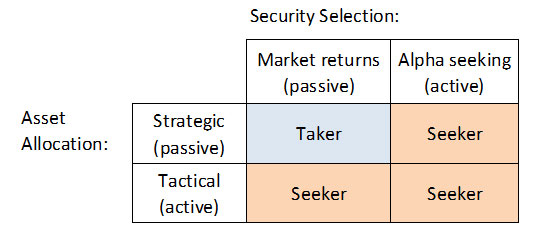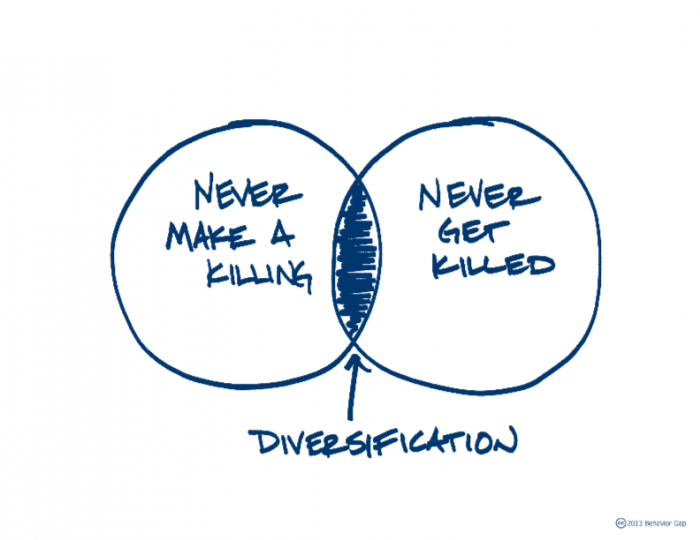by Rick Ferri
There are two categories of investors in this world: performance takers and performance seekers. A performance taker is satisfied with earning a fair share of the market’s return and weathering the risk that comes with it. A performance seeker wants more return and less risk, and pays for it in more than one way.
I am a performance taker. I believe the markets are going to outperform my feeble attempts to pick a winner, so I create a strategic (or fixed) portfolio asset allocation based on long-term needs and represent those asset classes using low-cost index funds that track the various markets. The strategic allocation is held for the long term and kept in place through occasional rebalancing.
Performance seekers have to actively trade a portfolio in some way to achieve their objective of beating the markets and lowering risk. They attempt to accomplish this by changing their asset allocation when they believe it’s advantageous to do so, or through superior security selection within an asset class, or a combination of both.
Figure 1 illustrates the two basic investment dimensions of portfolio decisions. Rows represent two ways of creating an asset allocation and the columns represent two ways of selecting securities.
Figure 1: Performance Takers and Seekers

Source: Chart by Richard A. Ferri
Strategic asset allocation is a simple concept. An investor divides resources between risky and non-risky assets, and further divides them among individual asset classes to gain more diversification .This allocation shouldn’t change unless something new occurs in the course of the investor’s life. However, since markets can be volatile and not all asset classes move together, the portfolio periodically needs rebalancing to bring it back to its original asset allocation. See my book, All About Asset Allocation, for more information.
Tactical asset allocation is an active strategy. An initial asset allocation is set based on current market conditions, perceived risks and future returns; and then it’s adjusted over time based on what the investor believes the markets will do in the future. The idea is to avoid bad markets and participate in good markets, thus outperforming a strategic allocation.
Once a strategic or tactical asset allocation is decided, investors need to represent those asset classes in their portfolio. Here we have options: passive or active. Passive investments track individual market returns while active investments attempt to outperform those markets.
Many performance takers rely on low-cost index funds or exchange-traded funds (ETFs) to achieve market returns. An example is the Vanguard Total Stock Market Index Fund (ticker: VTSMX), which represents the entire US stock market, and the Vanguard Total Bond Market Index Fund (ticker: VBMFX) representing most of the investment-grade US bond market. There are many other types of index funds and ETFs that track indexes.
Passive investing also includes laddered bond and CD portfolios. An investor buys a series of bonds that mature in equal amount each year, holds them until maturity, and then rolls the proceeds another year out. There is no trying to predict interest rates in this strategy and that’s what makes it passive.
Performance seekers do make predictions and that’s difficult. If an actively managed US stock fund was purchased, there’s an assumption that it will outperform a comparable index fund. Active management occurs if individual bonds are bought and sold based on an assumption about interest rates.
One problem with performance seekers is the higher cost of trading. Being tactical in asset allocation requires regular trading in and out of asset classes. This increases the overall cost of portfolio management, and potentially creates tax liabilities also. Purchasing actively managed mutual funds is almost always more expensive than buying index funds.
A second problem performance seekers face is the “zero-sum game.” Trading back and forth with other investors doesn’t change the return of market; it only affects each investor’s return and adds cost. For every winner, there is a loser before cost and often two losers after cost.
I’m a performance taker because being a performance seeker is too expensive and too risky. For me, investing is all about the probability of success, and I hang my hat on a strategy that’s going to deliver what the market will bear in the long term. As Warren Buffett once said, “I’d rather be certain of a good return than hopeful of a great one.”
Copyright © Rick Ferri














